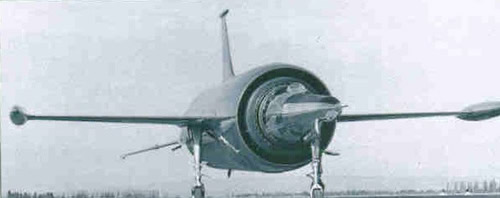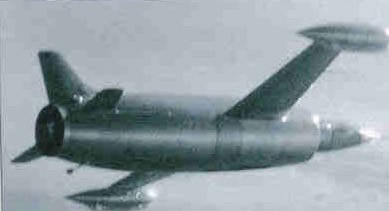|
French Ramjet
Experiment, the Amazing LEDUC O.21
Raul Colon
e-mail:rcolonfrias@yahoo.com
Telephone / Fax 787-748-7312
PO Box 29754
Rio Piedras, Puerto Rico 00929

French engineer pioneer Rene
Leducís fascination with aircraft propulsion started early
in his life. But it was not until his late thirties that
Leduc commenced a series of test designed to evaluate the
ability of a ramjet engine to propel an aircraft thru the
air. Known technically as aero-thermodynamic-duct, the
ramjet engine did not posses any major rotating mechanism.
It relays on air being force into the main intake. The
intake is designed to deprive the air of its kinetic energy
and replace it with massive amounts of pressure. From the
intake, the air goes thru a diverging duct to the combustion
chamber where burning fuel is added to it. The resulted
expanded gases are then exhausted producing vast amounts of
thrust.
Leducís first attempt at producing a workable ramjet system
in 1935 was deem as a success by French aviation
authorities. When the practical engine was turn-on, it
produces a sustainable 0.039kN or 9lb of thrust for three
minutes. An impressive achievement on those pioneer days. He
continued experimenting with ramjet designs into the late
1930s, but by this time, the clouds of war had settle over
France. He did not perform any research during the German
occupation. Once France was once again on its feet, Leduc
vigorous continued his research, culminating with the
construction of the O.10 aircraft in 1946. The O.10 was
mainly a test bed plane, intended to collected data on the
performance of an airframe fitted with a ramjet engine.
Between 1946 and early 1948, the O.10 made several flights.
All as a glider. The O.10 was propelled to the air in the
back of a Languedoc commercial airliner. When the Languedoc
achieved the desire attitude, the O.10 would be release to
glide down to earth. The goal of gliding test flights was
the collection of data in regard to the aerodynamics forces
influencing the airframe and engine. Then in 1949, the O.10
engine was powered on for the first time during a test
flight. It reached 422mph during a brief twelfth minute
flight. Two sub sequential test flights failed to produce an
increase in speed. However, on the third test flight, the
O.10 reached the impressive mark of 500mph.
Two more prototypes aircrafts were design by Leduc. The O.16
and 17. Each achieves a better speed result and confirmed
the designer concept with actual flying experience. Although
impressive, these aircrafts were not ground breaking
platforms. That would be the job of the next O model; the
amazing O.21. The O.21 incorporated some characteristics
from earlier O. versions, but at its core it was a
completely new design. Leduc called for the O.21 to have an
operational service ceiling of 65,600ft with a climb rate of
656ft/sec at sea level and up to 131ft/sec at 29,500ft.
Because the aircraft was a second generation test system,
operational range was not establish; but engineers
calculated that the O.21ís ramjet could operated for
approximately fifteen minutes after initial ignition. The
O.21 had a wing span of 38ft. The fuselage was 41ft in
length with a height of 9ft. The whole wing area cover 239sq
ft. Its maximum take-off weight was a respectable 13,200lb.
The installed power plant was a Leducís ramjet augmented by
one Turbomeca Artouste auxiliary turbojet. The Artouste
turbojet was to provide the O.21 with the require thrust to
accelerate the aircraft to an assigned speed in order to
ignite the ramjet engine. This allowed the O.21 to take-off
under its own power. After the ramjet was ignited, the O.21
could reach speeds in excess of 620mph.

The O.21 airframe was basically
a ďflying engineĒ configuration. It was made of six
concentric stainless steel skins, which were joined by
perforated burner crowns. The ramjet engine was located at
the end of the cockpit and was to be the center of the
airframe. The cockpit was conical in shape and could be
jettison in case of an emergency. The pilot sat in a
semi-reclined seat. At the rear of the seat were the radio
equipment, oxygen supply system, the cockpit parachute, and
the aircraft avionic systems. A retractable, tandem
undercarriage was assemble for the O.21. Additional, two
fairings on each wingtip housed the retractable outrigger
wheels. Although the aircraft did carry any offensive
system, conditions provide the engineers the possibility of
mounting cannon systems on them.
On a clear morning on May 16, 1953; the O.21 took to the air
in its maiden flight. It performed as advertise. French
military officials were impress with the promise of a Mach
2-capable interceptor that can shoot down enemy bombers in
short notice, thus government funds were made available
immediately for continue research. After the O.21 program
had run its course, Leducís introduced the O.22 aircraft.
Although the O.22 broke the Mach 1 barrier, doing it on
October 1956, and showed much promise; it was not a
revolutionary aircraft as the O.21 was. In fact, it was
powered by a conventional turbojet engine. In the end,
advances in conventional aircraft and engine technology and
a stall on the research and development of ramjet engines;
led the French government to terminated funding for the
program in the fall of 1958. The O. program did produced
valuable data, especially on engine/airframe aerodynamic
behavior. Much of the research collected on the O.21 and 22
programs were to find its way into Franceís front-line
interceptor platforms of the 1960s and 70s.
References
French Aviation in the Twenty Century, Edt Bill Russell,
Martin Press 1991
2 Concept Aircraft: Prototypes, X-Planes, and Experimental
Aircrafts, Edt Jim Winchester, Thunder Bay Press 2005
3 Ramjet, The Evolution: 1914-1960, John Connelly, (Paper)
1965
|
